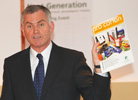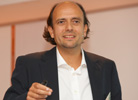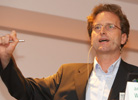| |
An audience of nearly 120 participants, representing the carton and folded box industries, proprietary manufacturers, trade and design, academia and the press, followed the dual conference and subsequent discussion attentively.
Univ.-Prof. Dr. Wolfgang Wimmer / Dr. Stefan Gara, Technical University Vienna
Let us put aside the topic of sustainability as an additional attribute to other things, such as quality, for the time being. Let us not talk about sustainability, but let us take it a step further "in search of excellence".
When we think about "excellence" we should follow Nature's examples. When we speak of packaging we have immediate associations with nuts or bananas, which represent ideal forms of packaging. Inherent recycling is part of their evolution. Ideally, these would be the type of products required in a "gentle" industrial society.
We have based our presentation on four key issues:
1. When does a system become critical?
Human beings are used to linear thinking, we believe we still have time to brake when speeding towards a wall. However, some developments are so fast that our systems get beyond control. We are talking about excellence, not continuous improvement, we are talking about companies willing to accept the challenge.
2. Which break points can we expect in critical systems?
One point is the finality of fossile energies. You may have heard of the term "peak oil", describing how oilfields or the entire oil resources are exploited - it is a bell-shaped curve with a relatively pronounced drop at the end. And there are reliable indicators suggesting we have already passed the peak.
We are also undergoing a paradigm shift - we have all learned that toxicity is a matter of dosage or concentration. We have toxic limits for some 3,000 chemical compounds, yet in reality we have more than 300,000 compounds. The problem lies in their multiplicity and interactions, where even the smallest amounts can lead to problems.
3. Which break points affect product development?
What does this imply for our system? We are talking about factor X. This is not about successive and gradual improvements, but about improvements which make up a new dimension in terms of efficiency, reduction of raw materials and recycling. It is a radical transformation in the way we do business as we are running out of time.
Photos from Japan show a disassembly plant where 1,000 washing machines are disassembled semi-automatically per shift. It is a different way of thinking - how do we manage our resources? We put resources into products and then retrieve them. It is all about designing product life cycles, away from the linear approach towards thinking in cycles. This leads us to the question: how to design suitable cycles?
In today's world we can completely modernise an office workplace and still use 50 per cent of the existing elements. The customer de facto becomes our business partner, he will continue using our system if it can be upgraded. This is a shift from pure product development to a business model.
We live in a period of transition with completely new challenges, we need to change the ways in which we manage resources and energy. Business models which disregard "sustainability" are at risk. As product developers it is our responsibility to take these aspects into account prophylactically, in the sense of vulnerability.
An example from the field of mobility: Michelin have developed the "active wheel" which includes motor, suspension and shock absorber, all in one wheel. This allows us to manufacture automobiles in relatively small production structures !
4. How can we make companies ready for these challenges?
We are not talking about indivdual products, we are talking about business excellence. We have developed a model in the shape of a colour circle, which focuses on four major sectors: (1) New thinking, (2) new action based on new structures, (3) the identification of new potentials, and (4) the integration of new knowledge within the company.
Based on these four elements we have developed twelve indicators:
1. Leadership
2. Corporate culture
3. Management systems
4. Network & Value Chain
5. Participation
6. Social capital
7. Use of energy & materials
8. Financial capital
9. Life‐cycle management
10. Technological competence
11. Innovation & creativity
12. Vision / trends
The key issue will be, that managers truly implement these values in their companies, not simply pay lip service with well-phrased CSR brochures and alibi projects which bear no actual relevance to production. Unless this logic is not implemented consequently, one cannot move onto the next step. We are also talking about visions in the sense of the precautionary principle.
Here is an example for a CD cover: we calculated the carbon footprint of a CD for a renown manufacturer, for the product and the packaging. The overall footprint was 100 per cent, 50 for the product and 50 for the packaging, although the manufacturer had already gone to great lengths to reduce the footprint of the latter. Obviously there are limits as far as the CD goes, but major changes can be made in the packaging, i.e. by using carton. It just means using a different packaging, one not made of polycarbonate. What would be the results for such a cover? A lower carbon footprint and a lower water footprint.
We are talking about a new spirit, a new way of thinking, on how to integrate eco-intelligent products into future business models to remain competitive, and, as a final consequence, we are talking about Business Excellence.
The ensuing discussion focused on lifecycle calculations which showed that ecological products need not necessarily be expensive, and also as to whether and how regulatory bodies and the EU should take action. The event was concluded with a film showing thePro Carton/ECMA Award finalists. To be seen on www.cartonawards.com
|
 |
Franz Rappold, Pro Carton, President CEPI Cartonboard Europa, giving his welcome speech.
|
 |
Dr. Stefan Gara and ... |
 |
Univ.-Prof. Dr. Wolfgang Wimmer ... |
 |
in full swing! |
 |
The audience was captivated. |
 |
Dr. Andreas Blaschke, Board Member Mayr-Melnhof, moderated the discussion ... |
 |
... and thanked Dr. Rudolf Bergolth for his longstanding service in the PPV. |
|

